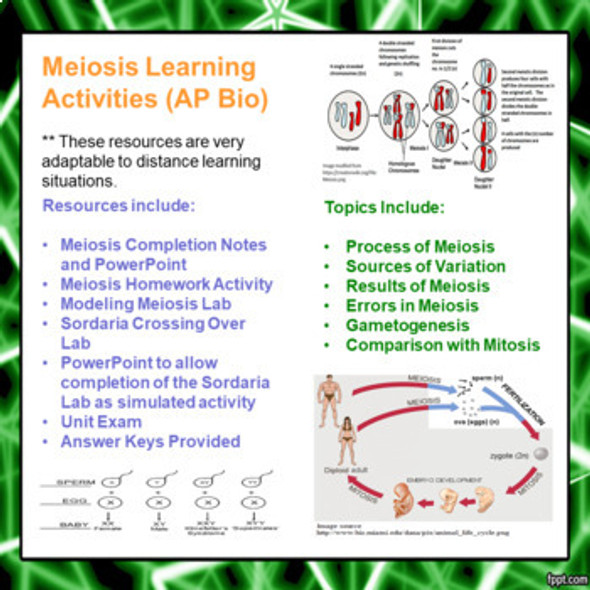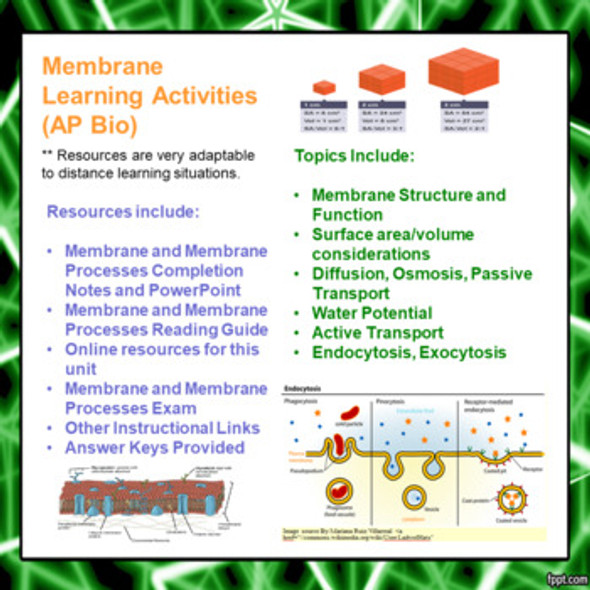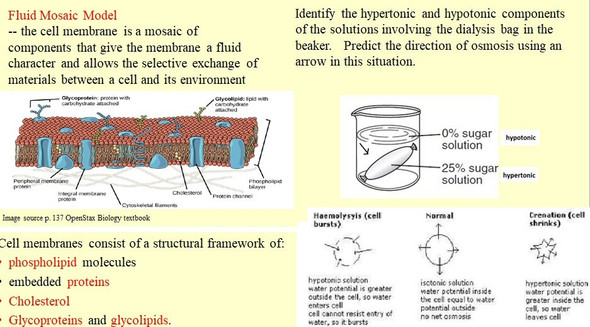Energy Flow and Successions Learning Activities for AP Biology (Distance Learning)
- Bulk Pricing:
- Buy in bulk and save
- Contributor:
- Monday's Rescue
- Grade Level:
- 9-12
- Product Type:
- Learning Package (Notes, PowerPoint, Homework)
- File Type:
- doc, pdf, ppt
- Pages:
- 60
- Answer Key:
- Yes
Description
This zip file contains many different activities (60 pages of student handouts and 1 PowerPoint with a total of 72 slides) which can be used to compose a unit for AP Biology or advanced Biology students involving aspects of feeding relationships, material cycling and successions. Some topics addressed in this unit include introduction to ecological organization, food chains, food webs, energy pyramids, major aspects and considerations of energy flow in an ecosystem. The cycling of carbon and nitrogen as well as successions including primary and secondary successions and much more. Computations involving energy flow are addressed within the energy flow in ecosystems worksheet. More specifics on the learning goals addressed in this learning package may be viewed near the end of this course description.
This package of learning materials has been completely updated for the 2019-2020 ETS curriculum changes.
While these lessons were originally designed for my AP Biology curriculum, they can be adapted to any advanced level Biology program. The Educational Testing Service also provides two labs which fit well with this unit. Links to obtain these labs are included in the "read me first" text file in this zip file package. This read me first file also contains links to an online textbook which can be used in replacement of traditional classroom textbooks.
The succession lab activity in this learning package is an excellent "stand-alone activity or activity to be used in conjunction with taking the students on a field walk to view successional changes.
This lesson packet contains a listing of the learning goals, common core learning standards, NGSS learning standards and the AP Biology performance indicators addressed in these materials. These are included in the packet and at the end of the description of this lesson.
The components of this lesson package can easily be displayed to students using an LCD projector and may be readily modified into formats facilitating smartboard technology. Most documents are included in both word and pdf format to allow editing for specific teacher needs. The learning guides/assignments contain links to online resources to support student learning.
Answer keys are included for all listed student work items. Files have been provided in both editable word and pdf format to allow you to edit the activities to meet the needs of the students in your classroom.
The specific contents of the learning package includes the following items (the page count for these items are actual student handouts as answer key page counts are not included):
-- Learning Goals, NGSS Correlations, ETS AP Biology and Common Core Learning standards correlations (3 pages)
-- Energy Flow through Ecosystems Completion Notes (17 pages)
-- PowerPoint to accompany the Completion Notes (72 slides)
-- Ecological Organization Worksheet (2 pages) (15 questions)
-- Energy Flow in Ecosystems Worksheet (8 pages) (includes 25 multiple choice and 13 short answer questions)
-- Cycles and Successions Worksheet (6 pages) (includes 26 short answer and 5 multiple choice questions)
-- Ecological Successions Reading and Lab Activity (12 pages)
-- Feeding Relationships, Material Cycling and Successions Exam (11 pages) (60 questions)
--Other free Learning Resource links pertaining to this lesson (1 page current as of 11/18)
ETS Learning Objectives for the AP Bio Exam
Enduring Understanding
ENE-1 The highly complex organization of living systems requires constant input of energy and the exchange of macromolecules.
Learning Objectives
ENE-1.M Describe the strategies organisms use to acquire and use energy.
ENE-1.N Explain how changes in energy availability affect populations and ecosystems.
ENE-1.O Explain how the activities of autotrophs and heterotrophs enable the flow of energy within an ecosystem.
Learning Goals Energy Flow through Ecosystems (local)
Upon completion of this unit the student will be able to:
1. define the term ecology.
2. explain the following terms associated with ecological organization; population, community, ecosystem and biosphere.
3. distinguish between abiotic and biotic factors.
4. define the term limiting factors.
5. list two conditions required for a self-sustaining ecosystem.
6. explain the difference between a food chain and a food web.
7. explain why a food web provides a more complete description of feeding relationships in an ecosystem than a food chain.
8. identify the role of producers, primary consumers, secondary consumers and higher level consumers in food chains, food webs and energy pyramids.
9. explain the difference between net and gross productivity.
10. list and describe how three different factors influence productivity.
11. discuss the inefficiency of energy transfer between trophic levels.
12. explain why food chains are limited in length.
13. relate the second law of thermodynamics to feeding relationships.
14. discuss the role of photosynthesis and respiration in the cycling of carbon in ecosystems.
15. describe why scavengers and decomposers are necessary in ecosystems.
16. discuss the roles of nitrogen-fixing bacteria, nitrifying bacteria, denitrifying bacteria and bacteria of decay in the nitrogen cycle.
17. explain what is meant by an ecological succession.
18. explain the difference between a primary and a secondary succession.
19. define the term pioneer organism.
20. list examples of pioneer organisms in a primary and a secondary succession.
21. explain why the dominant communities in a succession change over time.
22. explain what is meant by a climax community.
23. recognize that the climax community persists in an ecosystem until a catastrophic abiotic or biotic change disrupts it.
24. describe changes in biodiversity and soil organic matter during the progression of a succession.
NGSS Learning Standards
Students who demonstrate understanding can:
HS-LS2-1. Use mathematical and/or computational representations to support explanations of factors that affect carrying capacity of ecosystems at different scales.
HS-LS2-2. Use mathematical representations to support and revise explanations based on evidence about factors affecting biodiversity and populations in ecosystems of different scales.
Common Core State Standards Connections:
ELA/Literacy
RST.11-12.1 Cite specific textual evidence to support analysis of science and technical texts, attending to important distinctions the author makes and to any gaps or inconsistencies in the account.
RST.11-12.7 Integrate and evaluate multiple sources of information presented in diverse formats and media (e.g., quantitative data, video, multimedia) in order to address a question or solve a problem).
RST.11-12.8 Evaluate the hypotheses, data, analysis, and conclusions in a science or technical text, verifying the data when possible and corroborating or challenging conclusions with other sources of information.
WHST.9-12.2 Write informative/explanatory texts, including the narration of historical events, scientific procedures/ experiments, or technical processes.
Mathematics
MP.2 Reason abstractly and quantitatively.
MP.4 Model with mathematics.
HSN-Q.A.1 Use units as a way to understand problems and to guide the solution of multi-step problems; choose and interpret units consistently in formulas; choose and interpret the scale and the origin in graphs and data displays.
HSN-Q.A.2 Define appropriate quantities for the purpose of descriptive modeling.
HSN-Q.A.3 Choose a level of accuracy appropriate to limitations on measurement when reporting quantities.
Terms of Use
Purchase of the product is for classroom use by the purchaser only. It is a violation for individuals, schools, and districts to redistribute, sell, or post this item on the Internet or to other individuals.
This work is licensed under a Creative Commons Attribution-NonCommercial-ShareAlike 4.0
This learning package bundle is part of the AP Biology Complete Course. The complete course contains 22 learning package bundles in addition to this one. Save nearly 60% over the cost of buying 23 individual unit learning bundles with your purchase of the complete course.
Check out Monday's Rescue for more great resources!














